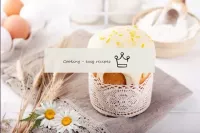Cake glaze that doesn't crumble
 4 servings
4 servings30 min
The main difference between this recipe and the classic one is that egg whites (and the eggs themselves) will not be needed to prepare the glaze. Since the popular protein glaze method uses raw eggs, many are afraid of contracting salmonellosis. This recipe eliminates this possibility. In addition, such a glaze, which includes gelatin, turns out to be more resistant and does not crack over time, standing outdoors. First of all, gelatin itself should be prepared. To do this, you need to pour it into some cup and fill it with 1/3 part of clean drinking water. Leave for a while until it swells. Gel balls should form on the surface. While the gelatin swells, you can make sugar syrup. To do this, place all the sugar powder in a small saucepan, pour the remaining drinking water, put on a stove and bring the mixture to a homogeneous mass over low heat. At the same time, so that the sugar does not burn, and the mixture turns out to be homogeneous, it is necessary to constantly stir the sugar syrup. Then remove the sugar syrup from the heat and cool slightly. Pour the sugar syrup into the bowl of the mixer and add the swollen gelatin mass there. Add some vanillin for a nice scent of future glaze. After that, pour in a few drops of lemon juice (preferably freshly squeezed) and mix all the ingredients well with each other. Next, you need to beat this mixture with a mixer. First at a low speed, gradually increasing power. It is necessary to beat until a snow-white glaze of the desired density is formed in the bowl. Ready-made glaze should be immediately spread on homemade cakes. Otherwise, it can freeze and do it will be very problematic. Beautiful culinary masterpieces!
Powdered sugar - 200 g, Gelatin - 5 g, Lemon juice - 10 mL, Vanillin - 1 g, Water - 120 mL
 Español
Español Français
Français Português
Português Русский
Русский 简体中文
简体中文 繁體中文
繁體中文 日本語
日本語 한국어
한국어 العربية
العربية Türkçe
Türkçe Қазақ
Қазақ Deutsch
Deutsch Italiano
Italiano Українська
Українська
